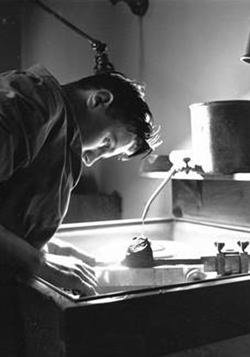The full version of this obituary appears below. Editor.
Respected palaeontologist with a special interest in plate tectonics and stratigraphy
 Hugh was an internationally respected palaeontologist who specialised in the ammonite biostratigraphy of the Cretaceous. He travelled widely across Europe, producing meticulously detailed descriptions of sections and faunas that provided a major contribution towards the resolution of the Aptian and Albian zones and their palaeogeography in the Boreal and Tethyan faunal provinces.
Hugh was an internationally respected palaeontologist who specialised in the ammonite biostratigraphy of the Cretaceous. He travelled widely across Europe, producing meticulously detailed descriptions of sections and faunas that provided a major contribution towards the resolution of the Aptian and Albian zones and their palaeogeography in the Boreal and Tethyan faunal provinces.
Left: Hugh, aged 15, cutting the Beddgelert meteorite. Photo courtesy of Frank Owen.
Palaeontology
Hugh was born in southeast London in 1933 to Mary and Gwyn Owen, and was evacuated to the Cotswold Hills, where he first became interested in fossils. When he returned to London, he had access to the Cretaceous clay and sand pits of the North Weald, which resulted in a lifelong study of their faunas. On leaving school at age 15, he joined the British Museum (Natural History) (now the Natural History Museum) as a Scientific Assistant in the Mineralogy Department. From 1952 to 1954, he completed his National Service in the bomb disposal section of the Royal Pioneer Corps, where he was promoted to sergeant, a rank not usually achieved by conscripts. This experience proved useful years later, when visiting the Cretaceous sections in Worbarrow Bay, Dorset, which are in the Lulworth Ranges and, therefore, inaccessible to the public because of the presence of unexploded ordnance. When Hugh explained his previous army role, he was given access with the comment: “if you find anything dodgy perhaps you can de-fuse it for us.”
While in the Mineralogy Department, Hugh developed and published an improved method for preparing thin sections in the Mineralogical Magazine, 1957. Hugh used the method during the delicate task of preparing sections of the 1949 Beddgelert meteorite when he was still only 15 years old. In 1958, he published his first paper on the stratigraphy and zonation of the Cretaceous Gault Formation in the Proceedings of the Geologists’ Association.
In 1958, Hugh transferred to the Palaeontology Department where he remained until his retirement in 1993. Initially he was responsible for the fossil echinoderm collections, and later moved on to the cephalopods, principally the Permian and Mid-Cretaceous faunas. In order to become a more efficient researcher, he completed a BSc in geology at Chelsea College in 1965, followed by PhD at King’s College London, in 1969. His thesis, “Middle Albian Stratigraphy in the Anglo-Paris Basin”, later became the basis for a British Museum Bulletin article.
Other projects
During the 1970s and 1980s, in addition to continuing with his biostratigraphical research, Hugh acted as a consultant on several major infrastructure projects, including the M25/M26 London orbital motorway and the Channel Tunnel. He revised the Natural History Museum’s curation procedures and, in 1977, was responsible for the design and move of the palaeontology collections into the Museum’s new East Wing. In 1986, he was promoted to Deputy Keeper of Palaeontology, a position held until his retirement.
Hugh was a committed union member who cared deeply about staff welfare and was always available with kindly advice. He is remembered as one who fought for fairness and staff opportunities, notably during the pre-Fulton Report days of the 1960s, when a Scientific Officer management culture actively repressed the ambitions and advancement of some of those in the Experimental Officer class. He was very much the keeper of the department's memories, going back to the end of the Second World War.
In the 1970s, Hugh became interested in continental drift, plate tectonics, and the expanding Earth theory, which, at that time, were regarded as incompatible. Following a detailed review of magnetic reversals and palaeontological data of the ocean floor, he produced the Atlas of continental displacement, 200 million years to the present in 1983. It included detailed maps comparing how the continents align today with those of the past based on reduced Earth diameters. In a review of the atlas, the late Tony Hallam, who did not support the expanding Earth theory, wrote “One cannot fail to be impressed by the single-minded industry involved in this considerable undertaking, and the indefatigable pursuit of such an ambitious goal, such that oceanographers and palaeocartographers who accept the constancy through time of the Earth's diameter have been presented with a real case to answer.” Hugh regarded the atlas as his most important contribution to science. The principal criticism of Owen’s hypothesis, which aimed to combine the better parts of the expanding Earth and plate tectonics interpretations, was that no plausible mechanism had been put forward for the expansion.
Retirement
In retirement, Hugh carried on with his stratigraphical research unfettered by administrative duties. In addition to publishing papers on Cretaceous biostratigraphy and zonation and the expanding Earth model, Hugh also catalogued some of the Natural History Museum’s most important fossil collections, notably that of the late C.W. Wright. Hugh continued to mentor colleagues at the Museum and internationally, and took the opportunity to become a keen general aviation pilot, as well as building a significant collection of books and postcards on naval destroyers.
Hugh died on 1 March 2022. His wife Eileen, also a geologist, pre-deceased him in 2016. He leaves four children, Frank, Helen, Janet, and Clare, and was a greatly loved father, grandfather, and great-grandfather.
By Ramues Gallois and Frank Owen, with the help of David Lewis, Claire Mellish and Adrian Morter